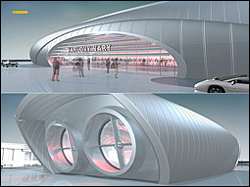
Karlovy Vary: construction of the airport terminal will begin from Petr Parolek
 |
Funding for the terminal's construction will be covered from the Regional Operational Program NUTS II Northwest, and it is expected that a grant will cover up to 85 percent of the costs. An additional 7.5 percent will be from state funding, with the remaining portion covered by the region's resources.
The terminal will be constructed by the company Stavby silnic a železnic. "The new check-in building is the work of architect Petr Parolek from Brno. After its opening, it will be possible to process three to four aircraft simultaneously," noted Deputy Governor Jan Zborník.
The new terminal features a futuristic design resembling the fuselage of a plane without wings. In addition to passenger check-in areas, it will also include space for commercial purposes, which can be utilized by travel agencies and airlines. "Upon completion of the entire third phase of the airport's revitalization, a comprehensive functional check-in complex will be created, which will also include the original hall. Its reconstruction, costing about 50.8 million crowns, began last May and will be completed by mid-March," said airport director Václav Černý.
The old hall had to be modified to ensure that passengers from the Schengen area do not mix with those from non-Schengen countries. For this reconstruction phase, the region received a grant of over 18 million crowns from the so-called Norwegian Funds. "The modernization of the original hall was very complicated because it was carried out while operations were ongoing. It is important that we meet the deadline set after the Czech Republic's accession to the Schengen area," added Zborník.
The Karlovy Vary Region, which took over the airport from the state in 2004, completed the first two phases of modernization in 2006 at a cost of over 146 million crowns. Strengthening and widening the runway cost 113 million crowns, and the installation of lighting and security systems around 33.3 million crowns. Of the total amount for both phases, the region received over 50 million crowns as an EU grant. Future plans also include resolving the road connection of the airport to the nearby R6 expressway.
Last year, Karlovy Vary Airport served a total of 64,641 passengers, of which 47,136 were on regular flights and 13,309 on charter flights. The airport recorded 4,196 transit passengers last year. Compared to 2006, the number of processed passengers increased by 82.65 percent, and compared to 2005, the increase was approximately 68.6 percent. In 2006, the airport was closed for three months due to construction work.
The most passengers last year were transported on the regular route between Moscow and Karlovy Vary by the airlines ČSA and Aeroflot, which was used by 43,078 passengers. A new regular route by ČSA to St. Petersburg, which began operations last June, served 4,058 passengers by the end of the year. According to Černý, the airport should reach a profit of around 2.7 million crowns for the last year. In 2006, it ended with a loss of nearly two million crowns, primarily due to unplanned downtime in the first and second quarters of the year.
In addition to regular flights by ČSA and Aeroflot to Moscow and St. Petersburg, Karlovy Vary airport will continue to offer charter flights this year. People will be able to fly to Antalya in Turkey or Rhodes in Greece and to Monastir in Tunisia. New routes will also include flights to Hurghada in Egypt and Heraklion in Crete. "We are negotiating routes to the Russian cities of Kyiv and Yekaterinburg. By 2010, a connection to the airport in Frankfurt, Germany, is realistic," noted Černý.
The English translation is powered by AI tool. Switch to Czech to view the original text source.
0 comments
add comment











